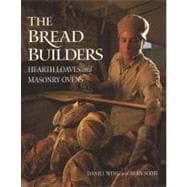
Note: Supplemental materials are not guaranteed with Rental or Used book purchases.
Purchase Benefits
What is included with this book?
| Acknowledgments | p. vi |
| Preface | p. ix |
| Introduction Looking for Real Bread, Finding Masonry Ovens | p. xiii |
| Naturally Fermented Hearth Bread | p. 1 |
| Visit: Upland Bakers, Marshfield, Vermont | p. 18 |
| Bread Grains and Flours | p. 23 |
| Visit: Giusto+s Specialty Foods, South San Francisco, California | p. 41 |
| Leavens and Doughs | p. 43 |
| Visit: Sands, Taylor, and Wood (King Arthur Flour), Norwich, Vermont | p. 69 |
| Dough Development | p. 72 |
| Visit: Acme Baking Company, Berkeley, California | p. 89 |
| Baking, Ovens, and Bread | p. 93 |
| Visit: Consulting and Marketing Services, South San Francisco, California | p. 108 |
| Masonry Ovens of Europe and America | p. 113 |
| Visits: American Flatbread, Warren, Vermont | p. 123 |
| The Cheese Board, Berkeley, California | p. 127 |
| Preparing to Build a Masonry Oven | p. 129 |
| Visits: Mugnaini Imports, Watsonville, California | p. 149 |
| San Juan Bakery, San Juan Bautista, California, and Home Fires Bakery, Leavenworth, Washington | p. 153 |
| Masonry Materials, Tools, and Methods | p. 157 |
| Visit: Cafe Beaujolais, Mendocino, California | p. 169 |
| Oven Construction | p. 173 |
| Visit: Depot Town Sourdough Bakery, Ypsilanti, Michigan | p. 193 |
| Oven Management | p. 195 |
| Visits: Della Fatoria, Petaluma, California | p. 210 |
| Rani and Keith, Garberville, California | p. 213 |
| A Day in the Life at the Bay Village Bakery | p. 216 |
| Bakers' Resource: Sourdough Microbiology | p. 227 |
| Recommended Sources | p. 233 |
| Glossary | p. 236 |
| Bibliography | p. 243 |
| Index | p. 246 |
| Table of Contents provided by Publisher. All Rights Reserved. |
The New copy of this book will include any supplemental materials advertised. Please check the title of the book to determine if it should include any access cards, study guides, lab manuals, CDs, etc.
The Used, Rental and eBook copies of this book are not guaranteed to include any supplemental materials. Typically, only the book itself is included. This is true even if the title states it includes any access cards, study guides, lab manuals, CDs, etc.